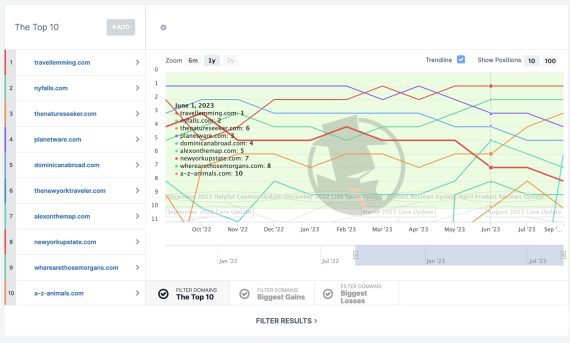Google’s latest “helpful content” algorithm update ended on September 15. It was disastrous for many sites.
If your site lost organic traffic, here’s how to recover.
1. Evaluate Losses
“Helpful content” is now a sitewide factor per Google’s Search Central guidelines:
Any content — not just unhelpful content — on sites determined to have relatively high amounts of unhelpful content overall is less likely to perform well in Search.
Hence the entire site suffers if Google claims extensive unhelpful content, making it difficult to identify which pages to focus on. Estimating the overall impact is the first step to identifying the scope. If it’s sitewide — in my view, 60% or more URLs have lost traffic — rework your whole content strategy.
Google’s Search Console identifies the pages that lost organic traffic.
- Go to the “Performance > Search results” report.
- Choose “Compare” in the “Date” filter.
- Choose “Compare last 28 days to previous period” and click “Apply.”
- Click on “Pages” and the “Clicks Difference” column header to sort by traffic changes.
Export the table to a spreadsheet for a better view of how many pages lost traffic.
2. Identify Competing Pages
Enough time has passed to identify external pages with traffic gains. Determine the search queries with the biggest ranking drops and find pages that gained what you lost. Tools such as Ahrefs, Semrush, Sitechecker, and others can produce this info. Look for URLs with meaningful ranking changes for each query.
Spyfu can also help. It offers a handy graphical representation of search rankings — URLs that increased and decreased for a given query.

A graph in Spyfu shows URLs with gains and losses in rankings for a given query, “my waterfall” in this example. Click image to enlarge.
Google’s definition of unhelpful content is, well, not very helpful. It’s content with “little value, low-added value or is otherwise not particularly helpful to people.” Analyzing winning competitor pages could provide clues. For each page, ask:
- Is the content more broad or more specific than yours?
- How is it structured?
- Does it contain keywords throughout the page?
- Is there a table of contents and jump-to links?
- Is there social proof — such as shares or comments — on the page?
- Is there an author byline that links to a bio?
- Does it contain Schema.org markup? How much?
- Does the content link to trusted sources?
- Does it include images or videos?
- Does it include data, trends, or stats?
- Is it new or freshly updated?
- Does it thoroughly address the query with FAQs and definitions as needed?
- Does it include related entities — reputable brands, products, people, places — or concepts that yours doesn’t? Text Optimizer can help identify those. It will analyze URLs on your site and a competitor’s, scoring both based on the number of related concepts and known entities. inLinks offers a handy entity checker, too.
- Has the site gained rankings seemingly out of nowhere? Google’s helpful content attempts to find “hidden gems,” low-ranking sites with excellent info. Finding one of those might inform Google’s priorities.
- Does the author’s bio state her experience and expertise relevant to the article?
The helpful content algorithm ranks pages for each query based on how searchers could benefit. Some queries require definitions and answers to common questions. Others seek clear steps or instructions to solve a problem or task. Your research aims to find what Google found particularly useful for each query.
Use the Wayback Machine to see a page’s earlier content. Perhaps it now contains better data, explanations, or sections that trigger the helpful content filters.
3. Show Fewer Ads, Popups
Quite a few discussions on SEO forums suggest that heavily monetized sites have lost the most rankings, especially those with intrusive interstitials or excessive ads.
“Intrusive interstitials” are popups that block most of the screen. These are typically email signups or special offers that require exiting to interact with the page. Disable or replace them with smaller, less onerous elements.
Google’s Search Central blog cites “excessive ads” as a negative user experience, although it doesn’t specify what it considers excessive, only “ads that distract from or interfere with the main content.”
Regardless, the harm of massive popups and excessive ads goes beyond the helpful content update. They impact readers. Avoid them irrespective of Google.




